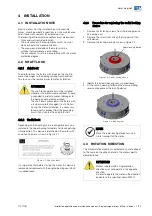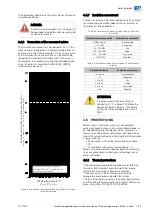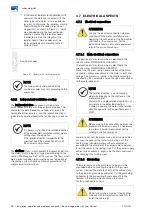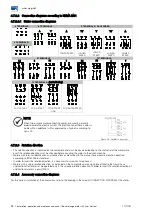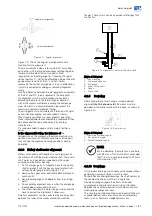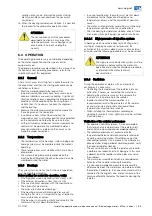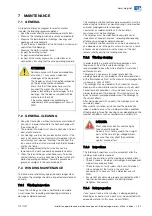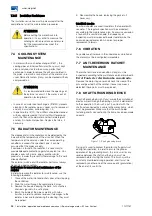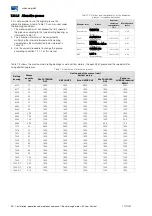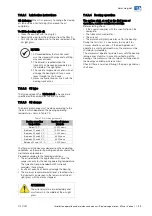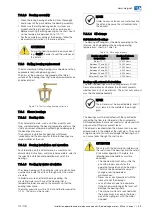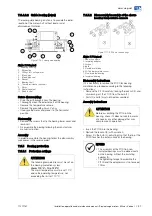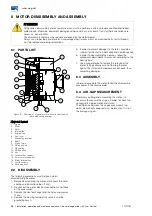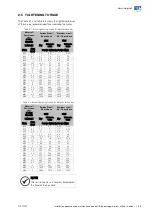
34 l
Installation, operation and maintenance manual – Squirrel cage motor – M line – Vertical 11371757
6
COMMISSIONING
When the motor is started for the first time or after a prolonged standstill, several aspects must be considered besides the
regular operation procedures.
ATTENTION
Avoid any contact with electric circuits;
Even low-voltage circuits may be life threatening;
In any electromagnetic circuit, overvoltages may occur under certain operating conditions;
Do not open an electromagnetic circuit suddenly, because the presence of an inductive discharge voltage
may break the insulation or injure the operator;
In order to open those circuits, disconnect switches or circuit breakers must be used.
6.1
PRELIMINARY INSPECTION
Before the first motor start or after long periods out of
operation, the following items must be inspected:
1.
Check if all the motor fastening bolts are tightened;
2.
Measure the winding insulation resistances , making
sure they are within the specified values;
3.
Check if the motor is clean and if the packages,
measuring instruments and alignment devices were
removed from the motor operating area;
4.
Check if coupling connecting components are in
perfect operating conditions, duly tightened and
greased, where necessary;
5.
Check if the motor is correctly aligned;
6.
Check if the bearings are properly lubricated. The
lubricant must be of the type specified on the
nameplate;
7.
Check the oil level of oil-lubricated bearings. Bearings
with forced lubrication must have the oil pressure and
flow as specified on their nameplate;
8.
Inspect the cable connections of accessories (thermal
protectors, grounding, space heaters, etc.);
9.
Check if all electrical connections comply with the
motor connection diagram;
10.
Check if the motor is properly grounded;
11.
The cables connected to the stator and rotor main
terminals must be properly tightened in order to
prevent their short-circuit or loosening;
12.
Inspect the cooling system. In water-cooled motors,
inspect the operation of the radiator water supply
system. In motors with independent ventilation, check
the rotation direction of the fans;
13.
Motor air inlets and outlets (if any) must be
unobstructed;
14.
The moving parts of the motor must be protected to
prevent accidents;
15.
The terminal box covers must be correctly fastened;
16.
Check if the power supply voltage and frequency
comply with the data on the motor nameplate;
17.
Inspect the operation of the anti-reversion devices (if
any).
18.
Check if the radial locking device on the upper
bearing (if any) has been replaced, as per item 4.2.3;
6.2
FIRST STARTING
6.2.1
Starting procedure
After all preliminary inspections have been carried out,
proceed according to the directions presented next in
order to perform the first start of the uncoupled motor:
1.
Turn off the space heater;
2.
Set the protections in the control panel;
3.
In oil-lubricated bearings, check the oil level;
4.
In bearings with forced-lubrication, start the oil
circulation system and check the level, flow and
pressure of the oil, making sure that they comply with
the data on the nameplate.
5.
If the system has oil flow detection equipment, it must
be waited until the flow return signal from the oil
circulation system of both bearings is received, which
makes sure that the oil has reached the bearings;
6.
Start the industrial water cooling system checking the
required flow and pressure (motors with air-water
heat exchanger);
7.
Turn on the fans (motors with forced ventilation);
8.
Switch on the high-pressure oil injection system (if
any), keeping it on as informed in the motor technical
documentation until the bearings get the lubrication
by self-pumping;
9.
Rotate the motor shaft slowly in order to check that
no part is being dragged or any abnormal noises are
occurring;
10.
After the previous steps have been adequately
completed, it is possible to proceed with the motor
starting sequence;
11.
Start the motor with no load, making sure it rotates
smoothly without strange noises;
12.
Check the rotation direction with the motor
uncoupled;
13.
In order to invert the rotation direction, just invert the
connections of any two phases;
ATTENTION
In order to invert the rotation direction of
motors with single direction, it is necessary to
consult WEG.
14.
Keep the motor rotating at rated speed and write
down the bearing temperatures at 1-minute intervals
until they become constant. Any sudden increase in
bearing temperature indicates lubrication or friction
surface abnormality;
15.
Monitor the temperature, the oil level of the bearings,
and the vibration levels. If there is a significant


